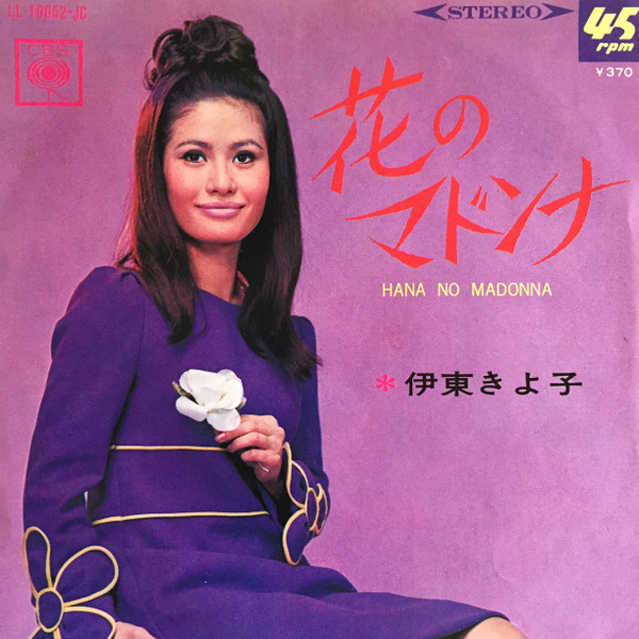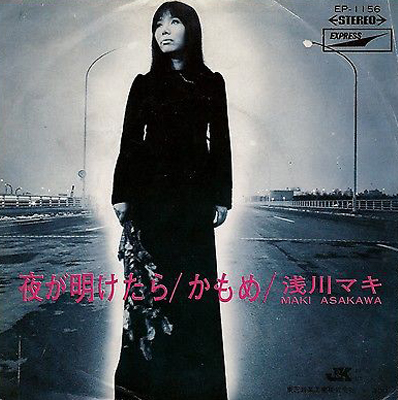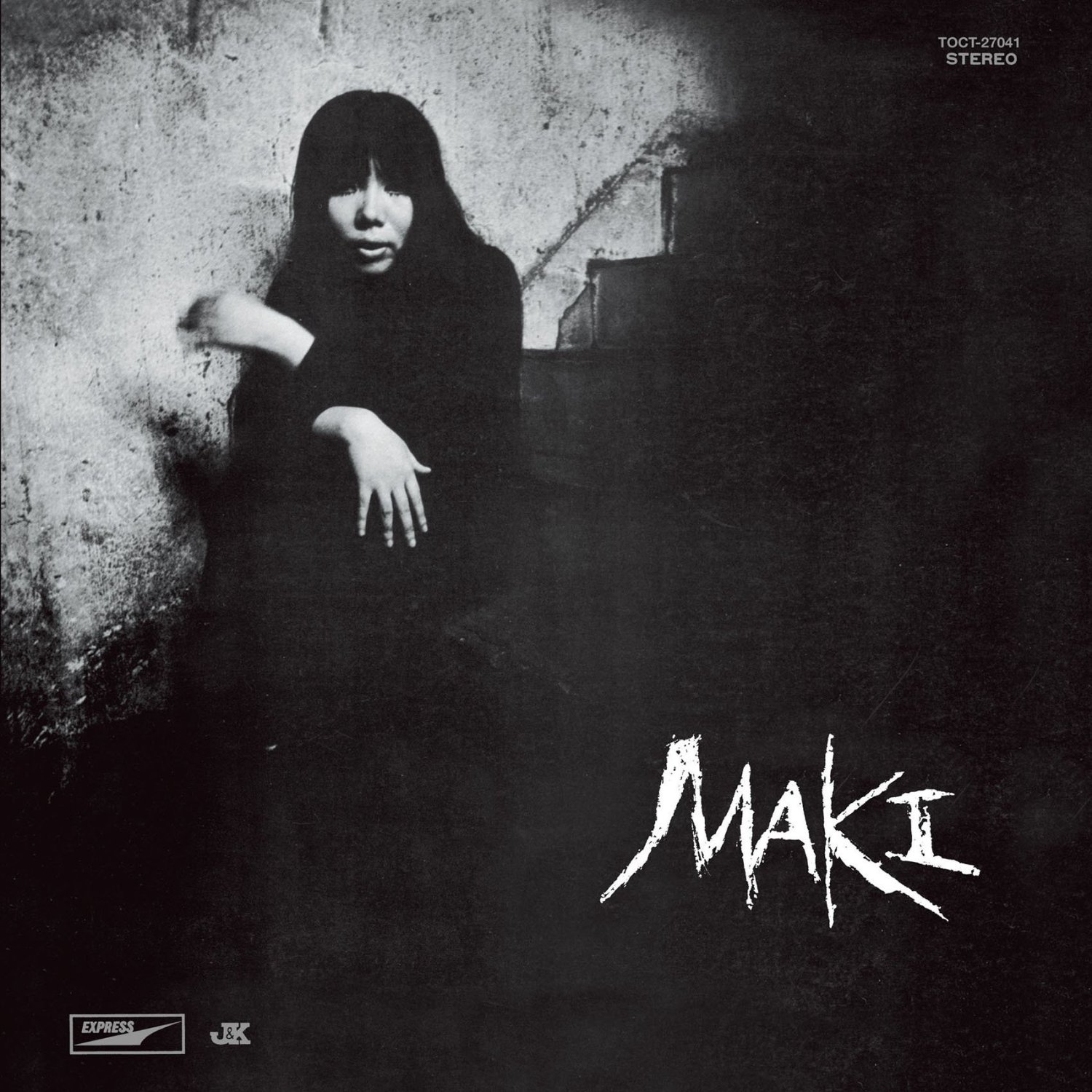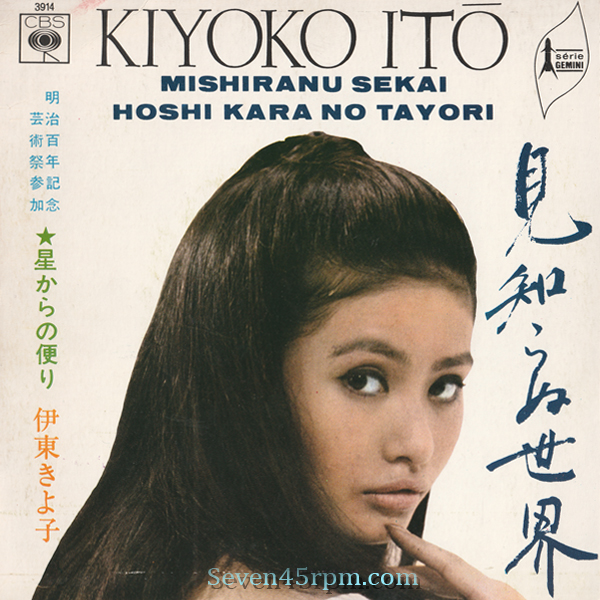KIYOKO ITÕ – Hoshi Kara No Tayori
CBS/Sony – SONA 86009 Released 1968
Track A – Hoshi Kara No Tayori (A Letter From The Stars)
Here is a “drifty” sweet release from Kiyoko Ito with a beautiful sprinkling of psychedelia. Perhaps more tempered and whimsical than my normal up beat dancers from the sixties gals, but it’s too good to not share this one!
There’s not very much I can find on Kiyoko, other that she was born on January 24, 1947, possibly in the northern island of Japan, in Sapporo, Hakkaido. After graduating from Aoyama Gakuin High School in 1964, she entered Takarazuka Music School. She passed the audition for Toho’s International Dancing Team and appeared as a dancer in the musical “No Strings” in June, but gave up dancing due to Achilles tendonitis. As a result, she dropped out of the music school.
Focusing on the folk songs that were popular among Japanese youth at the time, she decided to become a singer, and made her debut at the 1st Folk Song Festival held at The Nippon Theater on December 19, 1965. The following year, in May 1966, she passed the audition (of over 300 Japanese singers) for the popular American folk group New Christie Minstrels and became an official member. A group not really to my tastes, but they did have have amazing talent go through the ranks, such as Kim Carnes and Kenny Rogers. She went straight to the United States and remained with the group until her Visa expired in October.
 After returning to Japan, she signed a contract with Watanabe Preofessionals, and had her debut single in June1967 on Nippon Columbia’s CBS label with the song “Hana to Kojisan” written by Kurunosuke Hamaguchi . This became her first hit! For some reason, I cannot find this in any of her catalogue listings, let alone a recording or clip, but I’m sure it’s out there somewhere. I’m sure it’s just lost in translation. Ito then would go on to record twelve 7″ singles with the CBS/Sony label, as well as three albums, between 1967 to 1975.
After returning to Japan, she signed a contract with Watanabe Preofessionals, and had her debut single in June1967 on Nippon Columbia’s CBS label with the song “Hana to Kojisan” written by Kurunosuke Hamaguchi . This became her first hit! For some reason, I cannot find this in any of her catalogue listings, let alone a recording or clip, but I’m sure it’s out there somewhere. I’m sure it’s just lost in translation. Ito then would go on to record twelve 7″ singles with the CBS/Sony label, as well as three albums, between 1967 to 1975.
This featuring track “Hoshi Kara No Tayori” (A Letter From The Stars), is actually the B side to her euphonious upbeat Mishiranu Sekai single, one of three releases from 1968. Both sides of the single also appear on her 1969 LP Ballads Of Love. The year 1968 and sitars go hand in hand, and so many pop artists would experiment with introducing this sound with at least one song release of that year. And I’m ever so thankful for that! The trippy sitar introduces the song, a beautiful flavor that mixes in with the percussion and that 60’s bass that soon enters. A sweeping harp, then we receive Ito’s voice. I really wish I had a translation to this song. Of course it’s not always needed, especially in this case, as we are taken away and fall lusciously into her vocal clouds, but I do imagine the lyrics are about spirit, love and innocence. And it does after all translate to A Letter From The Stars.
As far as other release from Kiyoto Ito that take me away to that faraway dreamy place, she released the beautiful “Namida no Binzume” as a 1969 single, and is just as delightful as the featured track, sans sitar and psychedelics. This track also appears on the Ballads Of Love LP. I also love “Hana No Madonna” also from 1968, and a bit more of a dancer. And for your exotica lounge soiree, the 2 sider “Talking To Myself” and “Soon Will Be Morning” 7 inch from 1972, is an absolute goodie!


So there you have Kiyoko’s sweet, psychedelic love song release, and after a few listens, like a whispering haze, I’m sure it will seep delightfully into beating heart. I would love to be enlightened on anything more about this wonderful singer, from anywhere out there in the world.
– DJ del Piero
Maki Asakawa – Chicchana Toki Kara
Express Compact ETP-4277 Japan 1970

 Track 1 – B2 Chiccana Toki Kara
Track 1 – B2 Chiccana Toki Kara
Track 2 – A1 Yoru Ga Aketara
Maki Asakawa was a born in Ishikawa Prefecture, January 27, 1942. After graduating high school she worked as a civil servant for a short time before moving to Tokyo to pursue a far more inspirational career in music. She started by playing at United States military bases and cabarets, where she refined her style, which she says was largely influenced by Blues queens such as Billie Holiday and Mahalia Jackson.
 In 1967 Asakawa made her debut recording, releasing Tokyo Banka with B side Amen Jiro on Victor. In 1968, Asakawa got her big break when she appeared for three days running at the Shinjuku underground theater known as Sasoriza, a project of underground playwright Shuji Terayama. She soon signed with Toshiba, and by the next year had released the very, VERY cool and slick Yo ga aketara (At the Break of Dawn) and Kamome (Gull) on Toshiba’s subsidiary Express label.
In 1967 Asakawa made her debut recording, releasing Tokyo Banka with B side Amen Jiro on Victor. In 1968, Asakawa got her big break when she appeared for three days running at the Shinjuku underground theater known as Sasoriza, a project of underground playwright Shuji Terayama. She soon signed with Toshiba, and by the next year had released the very, VERY cool and slick Yo ga aketara (At the Break of Dawn) and Kamome (Gull) on Toshiba’s subsidiary Express label.
1970 saw this featured Asakawa release, which has as the B2 track, Chicchana Toki Kara. This wonderful, yet not easy to find EP, has to be my favourite from Maki, with it’s big beat drive, high energy horns and cinematic production. Every time I play this I get comments as to how hasn’t Tarantino used this track for one of his movies. It’s 70’s sex, has a good amount of sting, and would be the ideal punch for a strong femme fatale introduction. And having the slow swinging Yo Ga Aketara as the opening track makes this 7″ a real delight (that distant train at the end…I mean really, what a way to see out such a cool track). Just the thought of seeing this performed in a dark underground club of Tokyo by Maki and that time just does my head in. The smoke, the black, the neons and the distant traffic outside…not too difficult to visualize. But this wasn’t just a time for Asakawa’s musical exploration.
In 1971, Asakawa made her big screen debut when she played the stairway prostitute in Shuji Terayama’s experimental Throw Away Your Books, Rally in the Streets. It was the first film for poet-playwright Terayama, and it was about an angst-ridden teen who hits the streets after dealing with his dysfunctional family. This hard to find movie has a strong underground following due to it’s non-linear Avant-Garde vision and amazing pre-punk psychedelic soundtrack. Asakawa’s recording of Nemuru No ga kowai is included amongst the tracks, and can also be found on her 1971 Maki II album, which by the way also include covers of Gin House Blues and The House Of The Rising Sun. That great LP also happens to include the incredible psychedelic Govinda (there should be a link below)…such a stand out Asakawa composition! The next year in ’72, Asakawa would release Blue Spirit Blues, and again here her voice somehow feels so right within the warm minor chords.
 In 1973 Asakawa would this time hit the small screen on the dark Japanese TV Series Kyôfu Gekijô Umbalance. From what I can put together, she appeared in season 1 episode 7, and I’m almost certain the link below is the clip from that episode, where she plays herself singing Yo Ga Aketara, on a cinema screen in a dark seedy theater, and with the dark seedy characters to match.
In 1973 Asakawa would this time hit the small screen on the dark Japanese TV Series Kyôfu Gekijô Umbalance. From what I can put together, she appeared in season 1 episode 7, and I’m almost certain the link below is the clip from that episode, where she plays herself singing Yo Ga Aketara, on a cinema screen in a dark seedy theater, and with the dark seedy characters to match.
 Over the next 30 or so years, Asakawa recorded quite a lot of records, but it wasn’t all dark moody blues and folk jazz. I discovered the Catnap album through a favourite blog, Interstellar Medium – Foriegn Lavish Sounds, which you should hit up, for a far more detailed look into the great album. Released in 1982, it’s a colourful, bold yet smooth collision of electronic jazz funk post punk plus, and for myself, it was so exciting to discover this side of Asakawa. The opening track Kurai Me Wo Shita Joyuu and also Shinkyoku B are real high lights, if I was forced to choose. This album holds up to quite high to today’s very standard standards in my opinion.
Over the next 30 or so years, Asakawa recorded quite a lot of records, but it wasn’t all dark moody blues and folk jazz. I discovered the Catnap album through a favourite blog, Interstellar Medium – Foriegn Lavish Sounds, which you should hit up, for a far more detailed look into the great album. Released in 1982, it’s a colourful, bold yet smooth collision of electronic jazz funk post punk plus, and for myself, it was so exciting to discover this side of Asakawa. The opening track Kurai Me Wo Shita Joyuu and also Shinkyoku B are real high lights, if I was forced to choose. This album holds up to quite high to today’s very standard standards in my opinion.
As Maki Asakwa grew older, she never stopped performing live. Just before an appearance on January 15-17, 2010 where she had a concert in Nagoya, she died of heart failure before the show could go on. She was 67.
References and inspirations…



Recent Comments